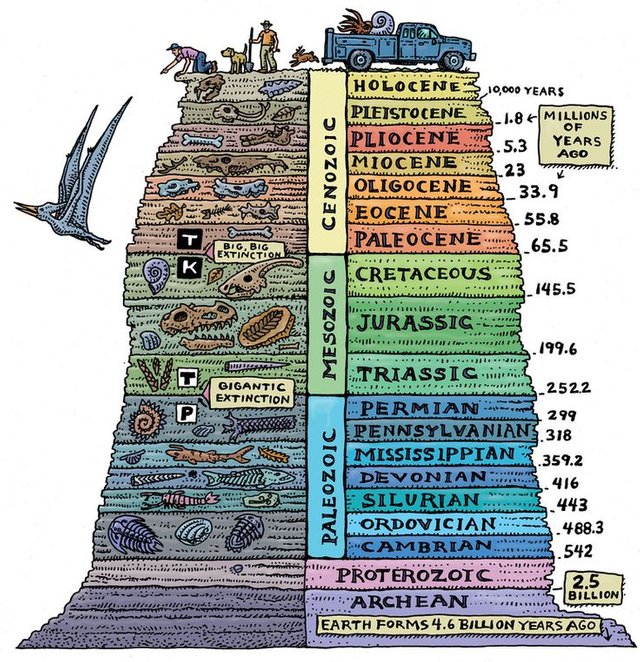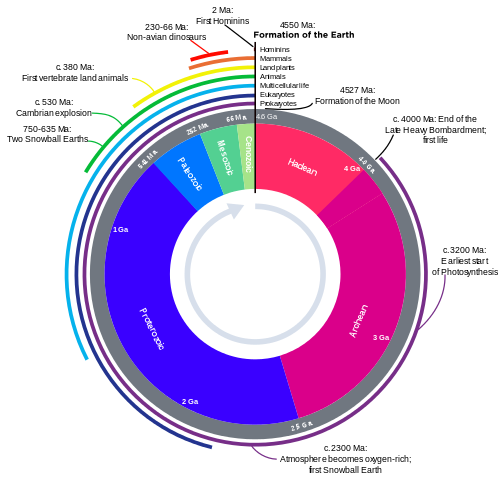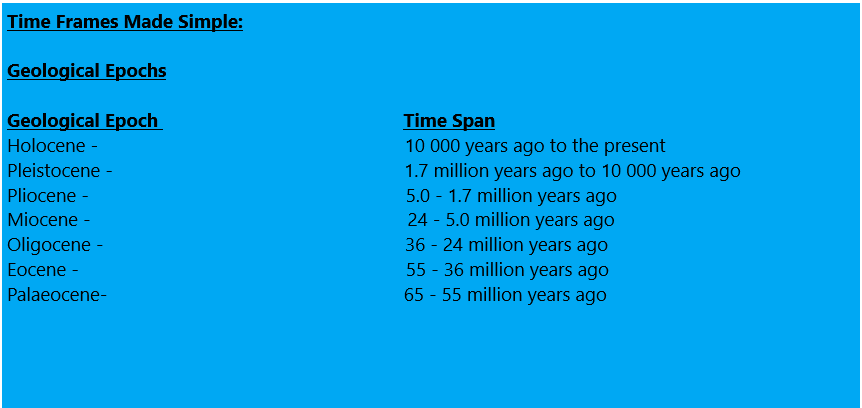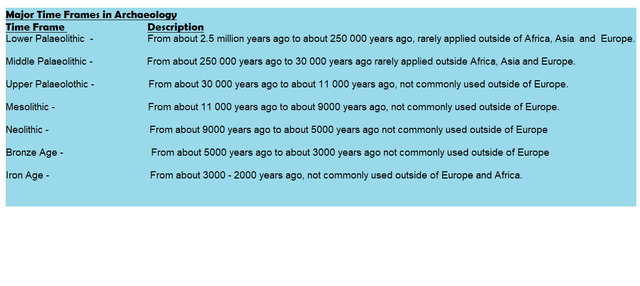Methods of Relative (Indirect) Age Determination used in Archaeology : Part 1 - Introduction
Methods of Relative (Indirect) Age Determination used in Archaeology
Introduction
Each and every culture (in an anthropological sense) is dynamic in that it is constantly changing, and re-adapting itself to its natural and cultural environment. These processes of adjustment and change take place over a long period of time, herein lies the dynamic historical aspect of culture.
It does not make any difference whether we are trying to establish the nature of the relationship between a series of single objects or sites or industrial complexes, and whether our investigation applies to a limited geographical area or to continents- we cannot make this correlation without taking the chronological aspect into consideration. In other words, before we can assign artefacts and/or industrial complexes to their proper cultural or ethnic context, we must know their comparative ages. As will be indicated, we distinguish between relative chronology (indirect age determination) and absolute chronology (direct age determination).
Relative Dating:
Relative dating refers to the process whereby the relative antiquity of sites and objects is determined by putting them in sequential order, but not assigning specific dates.
In the most basic terms, relative chronology tries to determine what is older and what is younger. The age specific archaeological material is determined by comparing it with other material (the age of which is already known or has been relatively determined) and this is expressed in a system which merely gives us a time sequence. Relative chronology therefore gives us a general time scale and does not enable us to say exactly when a particular event occurred, or what the absolute age of a specific object is - age is expressed merely in terms of an age ratio.
An Outline of the Geological History of the Earth.
The history of earth is divided into different geological eras, each of which is associated with the emergence of various forms of life. The eras are the Archaeozoic (or Azoic), the Palaeozoic, the Mesozoic and the Cainozoic (or Cenozoic). The Cainozoic is subdivided in turn into two geographical periods, namely the Teriary and the Quaternary.The Tertiary began about 70 million years ago and comprises the following geological epochs, the Palaeocene, the Eocene, the Oligocene, the Moicene and Pliocene.
The Quaternary, which spans a period of about 2.5 million years, is the geological period in which humans make their appearance as the creators of culture. It is subdivided into two epochs, namely the Pleistocene and Holocene. Research has revealed that in Europe the Pleistocene consisted of different ice ages or glacial periods which were separated from one another by warmer climatic periods (inter-glacial periods). Apart from the inter-glacial periods, fluctuations in the climate also occurred within the glacial periods.During these fluctuations or inter-stadial periods portions of the various ice-packs, which covered large areas of Northern Europe and the Alps, Melted and a moderate climate prevailed. the four glacial periods of the Pleistocene, which were established in 1909 by Penck and Bruckner for the Alps, are usually regarded as the basis for the subdivision of the Pleistocene. They are following : Gunz, Mindel, Riss and Wurm. Further investigations have shown, however, that is not possible to apply this scheme everywhere and a re-evaluation of the evidence in different parts of Europe and elsewhere has led to the development of new criteria so that the criteria of the classical Alphine divisions are no longer applied. In North America four Pleistocenen glacial periods, namely Jersey (or Nebraska), Kansas, Illinois and Wisconsin can be distinguished.
The Holocene, the current geological epoch, began, about 10 000 years ago. In the northern hemisphere it followed the last glacial period and the term "post-glacial period" is sometimes used instead on Holocene.
The terms terminus ante quem (date before which) and terminus post quem (date after which) are often used in relative chronology. Terminus ante quem (TAQ) provides a dating end point eg: the eruption of Mount Vesuvius in AD 79 that resulted in the destruction of the city of Pompeii, thus all archaeological deposits at this site date to AD 79 or to before this catastrophic event, similarly George Washington died in 1799, thus any document that bears his authentic signature must have been written and signed by him before 14 December 1799. In contrast terminus post quem (TPQ) indicates that an object or strati-graphic layer was deposited after a certain date eg: if a coin with the date 1795 is found in a layer of deposit then this layer cannot date before 1795 but must date to 1795 or sometime after this date.
Part 2 to follow ......
Please Follow me for more on Archaeology and History.
Please check out my other posts:
The Preservation of an Archaeological Site : Part 2
The Preservation of an Archaeological Site : Part 1
Discovering your own Archaeological Site : Part 3
Discovering your own Archaeological Site : Part 2
Discovering your own Archaeological Site : Part 1
Archaeological Sealed Sites and River Deposits : Is it an Archaeological Site or Not? - Part 3
Caves, Rock Shelters and Larger Open-Air Sites : Is it an Archaeological Site or Not? - Part 2
Is it an Archaeological Site or Not? - Part 1
Understanding the Archaeological Record : The Aims and Subject Matter of Archaeology - Part 2
The Aims and Subject Matter of Archaeology - Part 1
Archaeology and the Natural Sciences
Introduction to Ethnographic Analogy and Ethnoarchaeology
The Nature and Scope of Archaeology
The Three - Age System : The Stone Age, The Bronze Age and The Iron Age
The Roots of Modern Archaeology
Significant 18th and 19th Centuries Discoveries in Archaeology
Archaeology as a Profession- Part 2
Archaeology as a Profession- Part 1
To Become or Not Become an Archaeologist? - Introduction to Archaeology Part 2
Please Upvote and Resteem.
Thank You!




Welcome !! wish you best of luck @zest Now am Following You i like your blog
I am Isabella Chloe From El Monte california
I'm wrting post about Animals And All Upvoters Win Steem Dollars in Daily Contest if you interested! Then Follow my Blog And Upvote and Earn Daily . Thank you
@animal-lovers
Hi @zest, thanks for making all this information available to the enthusiastic fan of Archaeology and Paleontology. Your blog posts provide a valuable resource and I always look forward to seeing the next instalment.
Hi @petruska13. Thank you for your continuous support and your great comment. I really enjoyed your last post.
I am pleased that you are getting the success you deserve. I believe that good content will rise to the surface. My last post made me look back with more understanding of what my parents and grandparents went through. Going through the old letters and deciphering their contents was quite an experience. The world has changed a lot since that time but I can still feel the emotion in some of the letters.
This is really interesting as we travel a lot and go to archaeological sites, especially in Biblical lands.
Thank you @rosatravels.
Hi @steemiteducation. You are an amazing curator. Thank you for the support, recognition and recommendation.
Welcome to Steemit. However, I hesitate to articulate an appropriate rejoinder for I fear that my insufficient knowledge of extenuating circumstances surrounding the subject at hand might cause me to deviate from the path of veracity. Furthermore, I question the accuracy of many of the so-called techniques used now days to determine the age of things in the so-called distant past since they are based on so many unverifiable assumptions and ignored observations, no matter how logic they may appear to the limited human mind. " In the beginning God created ..."
Hello!!!
Welcome to steemit.com I am @pranjalphukan . Steemit community has the power to change our life if we simply upvote and follow each other. I joined steemit for a cause of helping my students.
Please follow and upvote me ( @pranjalphukan )and I will do the same for you.
Thankyou